Estimated reading time: 12 minutes
My mom loved cooking in her modern ‘nonstick’ pans – until that nonstick coating wore off and got in our food. Suddenly, those nonstick pans weren’t so palatable anymore. But there’s a better way, and my grandma knew it well – cooking with cast iron.
Cast iron pans of all types have been around for years and years, and they are still popular today. But what’s so great about cast iron?
In this article, we’re going to talk about what’s so great about cast iron, especially skillets. We’ll review the benefits of using cast iron skillets, how to season and maintain them, and what you can cook on them. We’ll even link to some great recipes that you can try on your cast iron skillet. Let’s get started.
Want to save this post for later? Click Here to Pin It On Pinterest!
Why Use Cast Iron Skillets
A deep skillet is one of the most versatile pans in the kitchen. And a cast iron skillet is even better.
- Sturdy. First of all, cast iron is nearly indestructible. There are no handles to break off and no bolts to come loose. It’s a solid piece of iron that is strong and sturdy. If it rusts, you can almost always restore it to a like-new condition (with just a little elbow grease). Cast iron pans can last for generations.
- Naturally nonstick. Cast iron skillets have a natural, nonstick surface that gets better with each use. If it gets ruined, you can easily fix it with a little bit of oil and heat in a process called ‘seasoning.’
- Holds heat. Once the pan is warmed up, it will stay warm and help keep your food hotter longer.
- Easy to clean. The natural nonstick surface of cast iron makes it just as easy, if not easier, than other types of cookware to clean.
- Works with multiple heat sources. You can use cast iron over any stovetop (electric, gas, induction), over an open flame (like a campfire), or placed in the oven.
- Inexpensive. Cast iron cookware is affordable and long-lasting.
- Comes in all shapes and sizes. The most popular cast iron is a large skillet, but they come in all shapes and sizes, from Dutch ovens to small skillets and even baking dishes.
- Goes from stove to table. Cast iron is aesthetically pleasing – you can take it right from the over to the table, and in fact, many restaurants do, which cuts down on serving dishes.
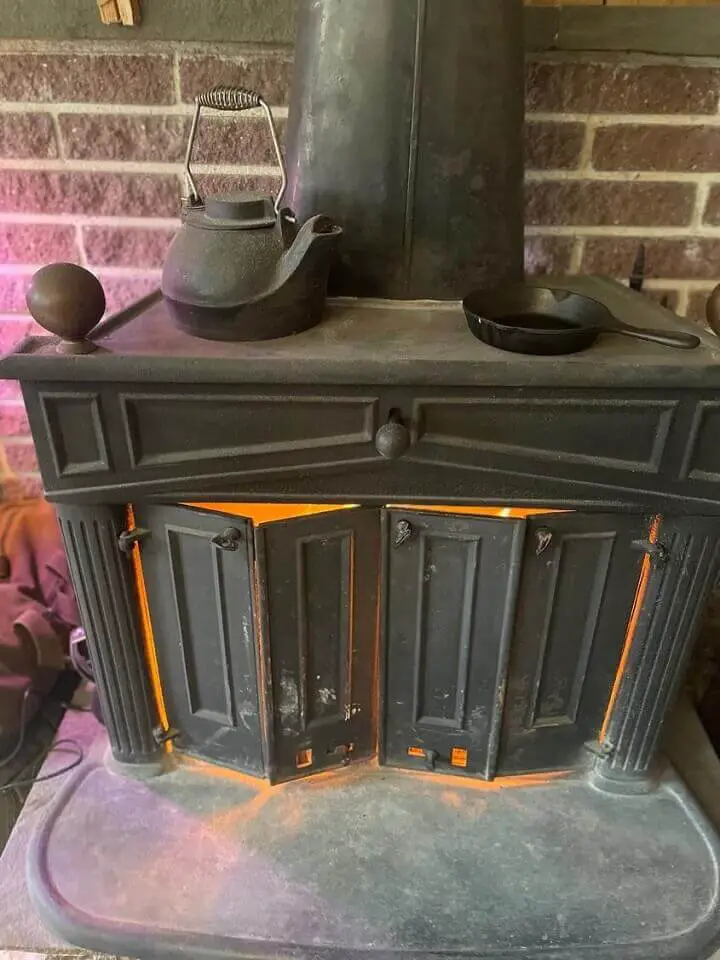
Why Cast Iron is Great for Off-Grid
Cast iron is great for off-grid living for the same reasons it is great in a modern kitchen. It’s tough and durable, and you won’t have to replace it constantly.
Even better, you can use it over an open flame just as easily as you would on your stovetop. You can nestle a Dutch oven into some hot coals to cook like a slower cooker or to boil water over a camp stove.
Because it’s naturally nonstick, it’s easy to clean without a bunch of harsh chemicals. A little scrub brush and some hot water is often all you need to get it clean again.
A Few Drawbacks to Using Cast Iron
To be fair, there are a few ‘cons’ to using cast iron.
- Hot handles. First of all, since the pots are all one piece, the handles can get just as hot as the pan itself. So make sure you protect yourself from burns by always using a potholder on the handle.
- It’s heavy. I won’t lie – cast iron pots and pans are heavier than aluminum or stainless steel. However, high-quality stainless pans are also heavy, so you’re in good company.
- It heats and cools slowly. Aluminum pans will heat up and cool off quickly – not so much with cast iron. This is because it has better heat retention. It just takes a little longer to get there.
- Some foods can wear down the surface of the pan. Acidic foods aren’t always great for us in cast iron. Sure, you can still cook them, but you might need to re-season your pan afterward.
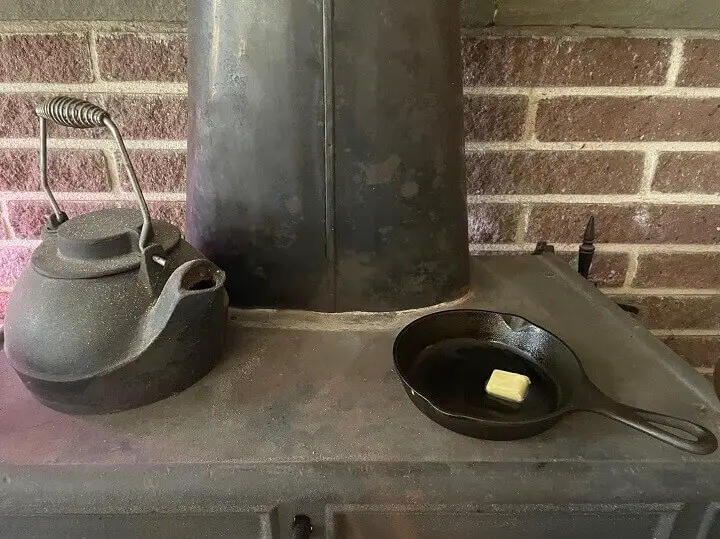
Cast Iron Rules and Tips
- Season Before Use. Proper seasoning is critical to your cast iron pan. New pans will often come ‘pre-seasoned,’ but it’s really easy to re-season your pan if you need to. When I use my cast iron skillet, I like to spray it with a quick spray of coconut oil and heat it to temp. Once it starts to just lightly smoke, I like to wipe the excess off with a paper towel (very carefully).
- Seasoning is Key. Even tricky foods can be cooked in cast iron, especially if you use a little extra oil or butter to season the pan first. The seasoning is the key to the nonstick coating.
- Preheat Your Pan. When I’m using my skillet, I find I get the best results if I preheat my pan, just like I would preheat my oven. This allows the heat to be distributed more evenly.
- Use the right size burner or flame. A flame or burner that is too small may cause the pan to heat (and therefore cook) unevenly. So make sure you use a burner that is as close to the pan size as possible for even heating and cooking.
- Reheat with water to release stuck on foods. For example, if you find that the food you cooked is really stuck to your skillet, you can reheat it with a little bit of water to help release the food.
- Don’t use soap! You don’t need to clean your cast iron pan with soap. A scrub brush and hot water should do the trick. To kill off bacteria, after you dry your pan, put it back on the stovetop and heat it up with just a bit of oil to re-season it. But don’t sweat it if you accidentally pour on a little dish soap – it likely won’t hurt your pan. It may remove some of the seasonings, but that’s easy to fix. Just avoid using harsh chemicals and never put them in the dishwasher.
- Be Gentle. I have a glass cooktop on my range. And while it’s fine to use your cast iron on a glass cooktop, just be mindful that you don’t drop or bang the heavy skillet onto the burner because it can crack or break your cooktop. Also, if you want to use metal utensils, you can, but be careful not to scratch the seasoning of your pan.
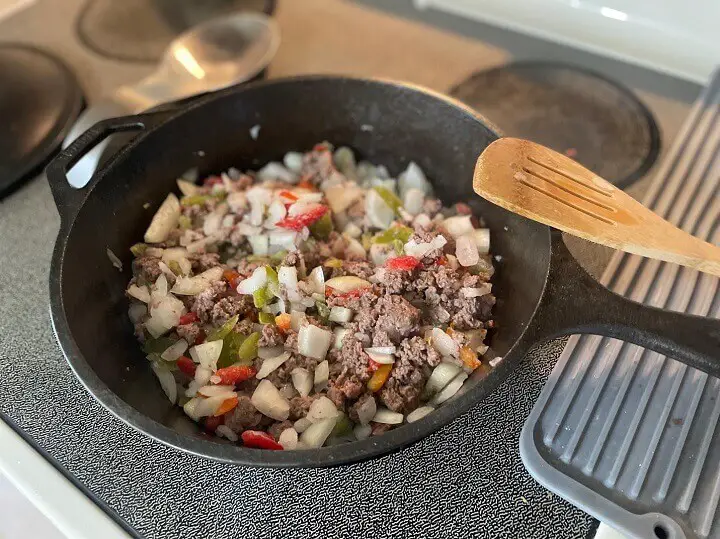
What Can You Cook on Cast Iron
You can cook almost anything in a cast iron pan that you can cook in an aluminum or stainless steel pan. My kids still talk about the day our power was out, and I made them oatmeal on the woodstove in a small cast iron pan – they thought it was the best oatmeal ever!
Skillet cookies are a breeze because you can warm them over low heat for long periods of time. In addition, the heavy pan keeps them from burning on the bottom. You can bake cakes in the oven in your cast iron skillet or even cinnamon rolls.
You can cook meat or other sources of protein, make pasta, soup, stew, potatoes, or almost anything you can think of. Cast iron is great because it can go right from the stovetop into the oven.
You can even reheat leftovers in your cast iron, which is really helpful if you can’t use a microwave. Just warm them up slowly over low heat. You may need to add a little bit of water to the pan to keep your leftovers from getting dried out.
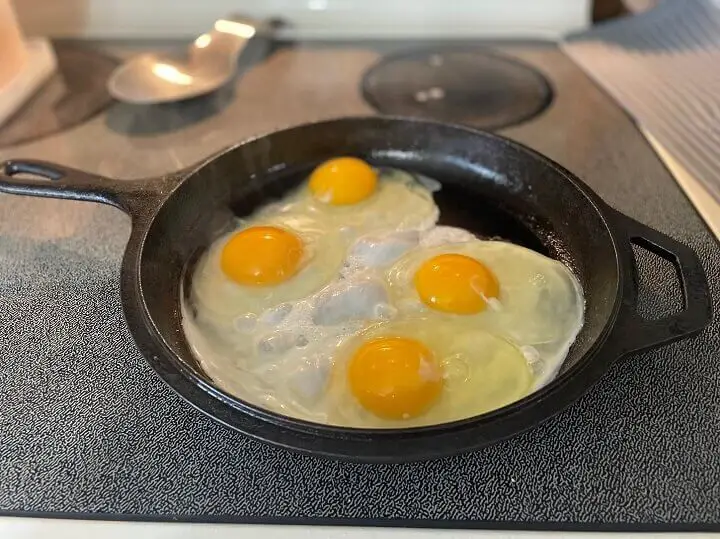
What You Should Avoid Cooking in Cast iron
It’s better not to cook highly acidic foods in your cast iron skillet, but some people do. A few things you might want to avoid cooking in cast iron are:
- Tomatoes
- Eggs
- Delicate foods like fish
- Sticky food
- Highly acidic foods
But this is just a guide, which I’ve broken often! If you do need to cook these foods in your cast iron, make sure that it is very well-seasoned. Eggs and fish can stick to the cast iron very easily, while tomatoes and highly acidic foods can break down the seasoning.
Keep in mind that I routinely cook eggs in my cast iron without issue as long as I use plenty of oil to season it first. Likewise, I have accidentally made spaghetti sauce in my cast iron, and while it did wear off some of the seasoning, it didn’t actually hurt the pan.
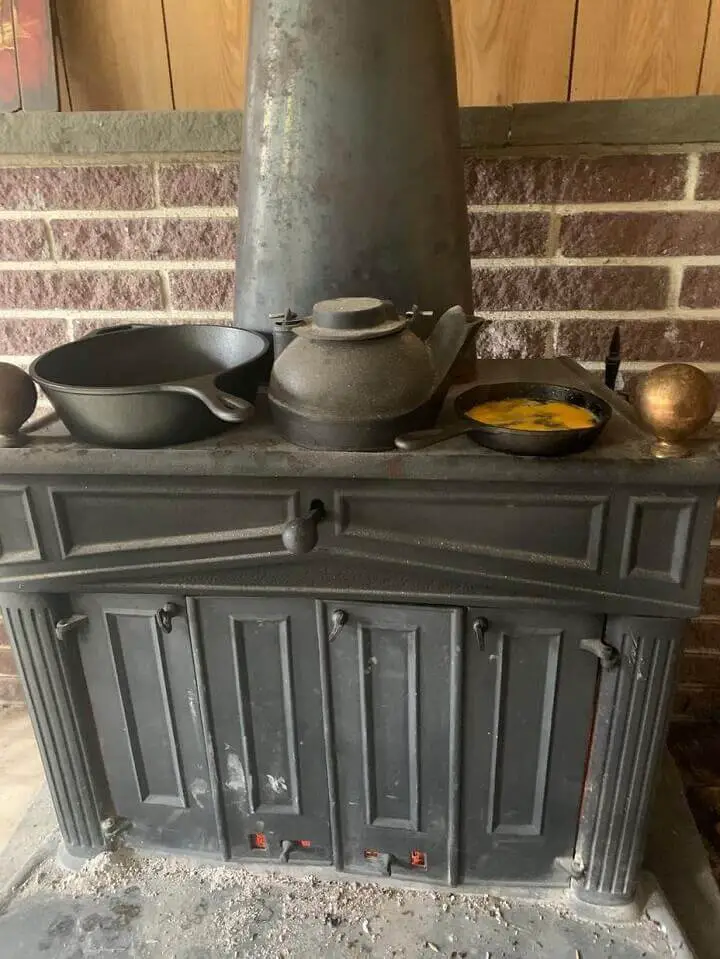
How to Cook with Cast Iron When There’s No Electric
I love cooking on my cast iron on my electric range, but when the lights are out, it’s a seamless transition to cooking without it. However, there are a few things to be aware of when you cook on your woodstove:
- Not all woodstoves are created equal. For example, some woodstoves have a very thin top, and the weight of a large cast iron pan with water may be too heavy for it.
- Your woodstove may not heat equally across the top. So, again, you’ll need to learn by trial and error where the best part for cooking is.
- A wide skillet is a good choice because you can move the food around to where it cooks best.
- Preheat your stove and your pan and bring them up to temp before you put the food in. Try to keep the temperature even by keeping the fire going consistently.
- Use a lid on your skillet. This will help keep the heat in so your food cooks more evenly.
- Practice makes perfect! You won’t get it right every time, but if you practice before the power goes out, you’ll know the best way to go about it.
If you are concerned that your woodstove can’t hold the weight of your cast iron, you can try cooking on the coals. Start a fire, then let it die down until it's just hot coals. Scrape all of the coals together into the center.
You can place your skillet with lid right onto the hot coals. It will cook like a slow cooker. It’s best if you have long, heat-proof gloves, so you don’t get burned.
What to Cook in Your Cast Iron
Here are some great recipes to get you started. I recommend practicing with your cast iron on your range before you try using a woodstove or campfire.
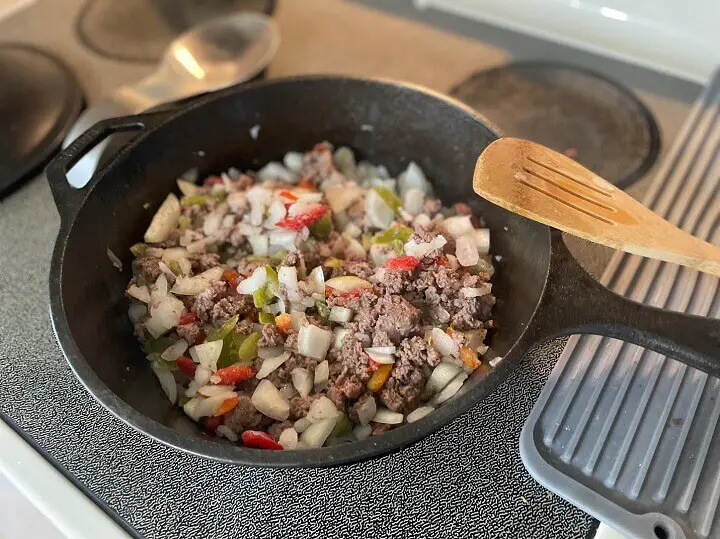
Cast Iron Recipes
Hamburger Casserole. I used my deep cast iron skillet for this depression-era recipe, and it turned out delicious! Of course, my family dove right in and asked for more. One of the best parts of this recipe is that you start by cooking it on the stovetop and you finish it in the oven. But you don’t need to put it in a different pan – you can just use your cast iron skillet for the top of the stove and inside the oven.
Doug and Stacey’s Off-Grid Egg Breakfast. Want a simple and delicious breakfast? Check out this one-pot meal by Off-Grid Doug and Stacey. It’s cooked in a cast iron skillet in their off-grid woodstove.
Egg Frittata. You can make an egg frittata on the stovetop or in the oven with this cast iron recipe from Cookie and Kate.
Corn Bread. Cornbread is a warm, filling, comfort food that you can easily make in your cast iron skillet. Check out this recipe for cornbread from the Pioneer Woman.
Chocolate Chip Skillet Cookie. Even Martha Stewart is into cooking with cast iron, and no recipe box would be complete without a chocolate chip cookie recipe like this one.
How To Season Your Cast Iron Skillet
To keep your skillet in good shape, you need to keep it well seasoned. As you use it, remember to add a little bit of oil while preheating the pan to keep it in good shape.
However, if you’ve let a little rust accumulate, or the seasoning breaks down, you’ll need to re-season it. It’s also good practice to give your cast iron a good seasoning with the change of seasons, so it's always in good shape.
Also, if you use your pan directly over a fire, it might need seasoned more frequently than if you just use it on the stovetop. Here’s how:
- To season your cast iron, you coat it with a layer of fat and then heat it until it smokes.
- If your pan is rusty, give it a good scrubbing to remove any surface rust. Dry it well.
- Cover the entire pan (inside and out) with a coating of oil or grease.
You can use the following:
- Crisco shortening
- Flaxseed oil
- Vegetable or canola oil
- Bacon grease
- Grapeseed oil
- Avocado oil
- Olive oil
- Coconut oil does not work as well, but I use it for in-between seasonings
Place the skillet in a 400-degree Fahrenheit oven for an hour. It will smoke! Repeat two to three times.
Alternatively, you can do this on the stovetop if you prefer. Just heat the skillet until it reaches it’s smoke point, then let it cool and wipe it dry.
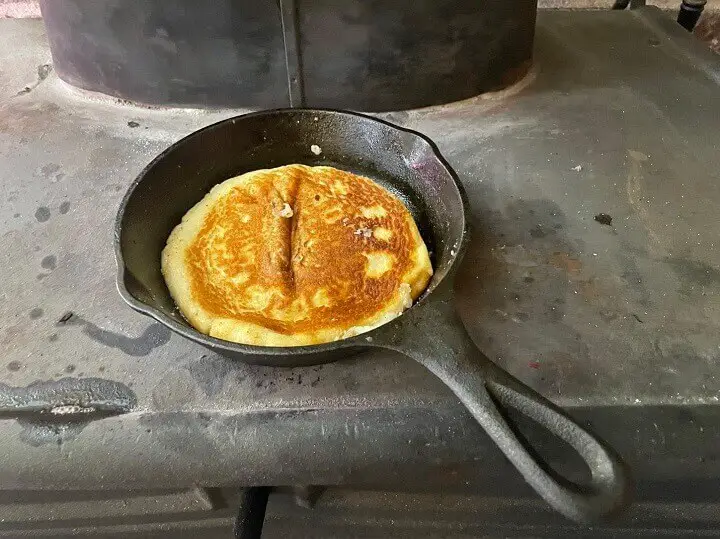
Final Thoughts on Cooking with a Cast Iron Skillet
You really can cook almost anything in a cast iron skillet. Just remember to:
- Keep your pan well-seasoned.
- Use the right size burner or flame.
- Preheat your pan.
- Use a lid, if possible.
- Be careful not to get burned on the hot pan or handle.
Using cast iron is just as easy – if not easier, than using any other type of nonstick pan. Whether you use it on the stovetop, in the oven, or on a woodstove or campfire, cast iron skillets are durable, efficient, and fun.
Like this post? Don't Forget to Pin It On Pinterest!
You May Also Like:



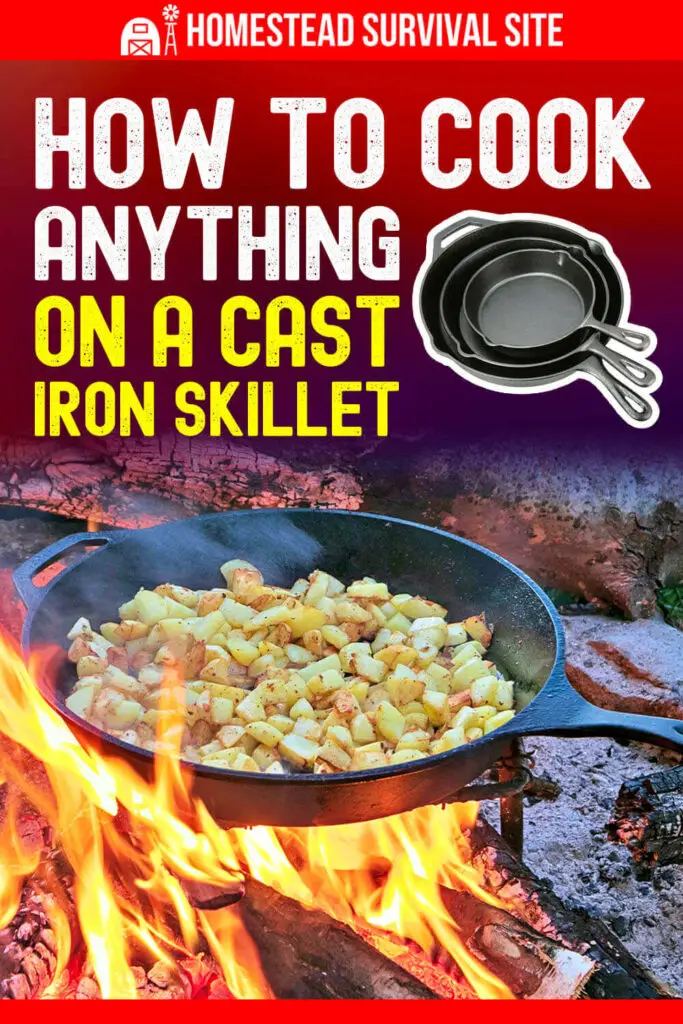

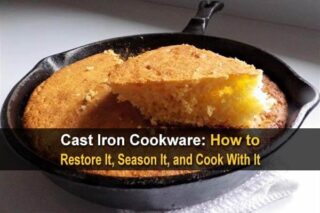


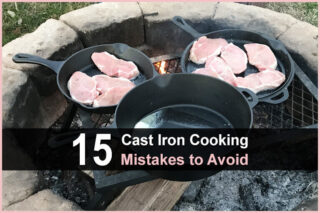
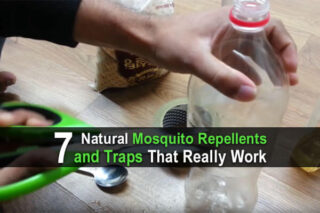
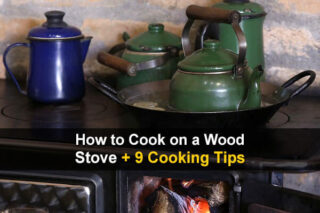


I love this story and very much love my cast iron skillets and Dutch ovens. Anything I can learn to continue bettering my technique is treasured! Thank you so much. I will try your recipes!